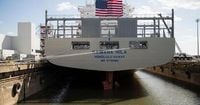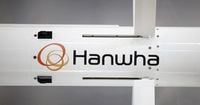On October 14, 2025, China’s Commerce Ministry announced sweeping sanctions against five U.S.-linked subsidiaries of the South Korean shipbuilding giant Hanwha Ocean, marking a dramatic escalation in the ongoing trade and maritime tensions between Beijing and Washington. The move, which sent Hanwha Ocean’s shares tumbling as much as 8% on South Korea’s Kospi index before closing 5.8% lower, targets a company at the heart of U.S. efforts to revive its struggling shipbuilding sector and signals Beijing’s willingness to strike at third-party firms it accuses of aiding American policies.
The sanctioned subsidiaries—Hanwha Shipping LLC, Hanwha Philly Shipyard Inc., Hanwha Ocean USA International LLC, Hanwha Shipping Holdings LLC, and HS USA Holdings Corp.—are now barred from doing business with Chinese organizations or individuals. According to a statement from China’s Ministry of Commerce, these units “have assisted and supported the U.S. government’s probes and measures against Chinese maritime, logistics and shipbuilding sectors. China is strongly dissatisfied and resolutely opposes it,” the ministry’s spokesperson said, as reported by CNBC and Reuters.
The sanctions come just as both China and the United States enacted new, retaliatory port fees on each other’s vessels. Beijing began collecting an additional 400 yuan (about $56) per net ton on American ships—charges that can add up quickly for container vessels weighing between 50,000 and 220,000 tons. The U.S., for its part, imposed steep new fees on Chinese ships docking at American ports starting at 12:01 a.m. EDT on the same day. Notably, China exempted vessels it built from its own new port charges, a move that underscores the strategic importance Beijing places on its shipbuilding industry.
The backdrop to this latest flare-up is the Section 301 trade investigation launched by the U.S. Trade Representative in April 2024, which scrutinized China’s dominance in global shipbuilding—a sector where China now commands more than half of all new construction, with South Korea at about 30% and Japan just over a tenth. The U.S. investigation concluded that China’s outsized role was a burden to American businesses and national security, prompting Washington to seek help from allies like South Korea and Japan to restore its own shipbuilding prowess.
Hanwha Ocean, which acquired the historic Philly Shipyard in Pennsylvania for $100 million in late 2024, has become a key player in these efforts. In August 2025, the company announced plans to invest $5 billion in new docks and quays at the shipyard, supporting the U.S. government’s ambitions to rebuild globally competitive shipbuilding capacity. Hanwha also secured contracts last year to perform maintenance, repair, and overhaul work for U.S. naval vessels, further deepening its ties to the American maritime sector.
China’s Ministry of Transport simultaneously launched an investigation into the impact of Washington’s Section 301 probe on its own shipping and shipbuilding industries. The ministry said it would assess whether companies, organizations, or individuals—including foreign entities—had assisted the U.S. in “undertaking discriminatory restrictive behaviours” against China’s shipping supply chain. This broad language leaves the door open for future, potentially wider-reaching countermeasures.
“China just weaponized shipbuilding,” Kun Cao, deputy chief executive at consulting firm Reddal, told the Associated Press. “Beijing is signaling it will hit third-country firms that help Washington counter China’s maritime dominance.” The sentiment was echoed by China’s Commerce Ministry, which described U.S. actions as a serious violation of international law and fundamental norms of international relations, according to Reuters. The ministry warned that further retaliatory measures could be forthcoming if Washington continued its current course.
The stakes are high for all parties involved. International shipping and shipbuilding have emerged as yet another arena of friction between the world’s two largest economies. The recent tit-for-tat actions follow a breakdown in the trade truce, with U.S. President Donald Trump threatening new 100% tariffs on Chinese imports after Beijing tightened export controls on rare earth minerals. The escalation has cast doubt on the prospects for a planned meeting between Trump and Chinese leader Xi Jinping later this month, though both sides confirmed ongoing working-level talks as of Monday.
For Hanwha Ocean, the immediate impact of the sanctions remains uncertain. The company said via email that it “is aware of the announcement made by the Chinese government and is closely reviewing its potential business impact on the company,” according to the Associated Press. Hanwha did not immediately respond to additional requests for comment from Reuters and CNBC. The South Korean government, meanwhile, is scrambling to assess the fallout. In a statement, South Korea’s Foreign Ministry said it “will communicate with relevant ministries, industry representatives and the Chinese side to minimize damages resulting from these measures.”
South Korea’s role in the unfolding drama is particularly complex. The country has long been a shipbuilding powerhouse—its firms, including Hanwha Ocean and rival HD Hyundai Heavy Industries, account for a sizable share of global output. South Korea has pledged to inject as much as $150 billion to help the United States revive its domestic industry. HD Hyundai is reportedly in talks to acquire U.S. shipyards as well, signaling a broader alignment with Washington’s goals.
Yet, these deepening ties with the U.S. come at a cost. China remains a vital market and manufacturing base for South Korean companies. Hanwha, for instance, operates a shipyard in China’s Shandong province that builds modules for final assembly in South Korea. The company announced in May it was withdrawing from a joint venture in China, perhaps anticipating rising risks amid the growing geopolitical rift.
For the U.S., the latest developments underscore just how far it has fallen behind in shipbuilding. American firms now represent just 2.9% of world fleet ownership by capacity and a meager 0.1% of global shipbuilding tonnage. President Trump has made revitalizing the industry a centerpiece of his broader push to expand U.S.-based manufacturing, insisting that help from allies like South Korea and Japan is essential to closing the gap with China.
Some industry observers worry that the cycle of sanctions and countermeasures could spiral further, ensnaring more companies and disrupting global supply chains. Others see the moves as a necessary assertion of sovereignty and strategic interest, given the centrality of shipbuilding to both economic and military power. As port fees bite and sanctions ripple outward, the world’s shipping lanes have become a new front in the contest for technological and industrial supremacy.
With all sides digging in and the stakes mounting, the Hanwha Ocean episode offers a stark illustration of how global industries can become collateral damage in the tussle between major powers. As governments and corporations weigh their next moves, the only certainty is that the world’s shipbuilding order is being remade—one sanction at a time.

